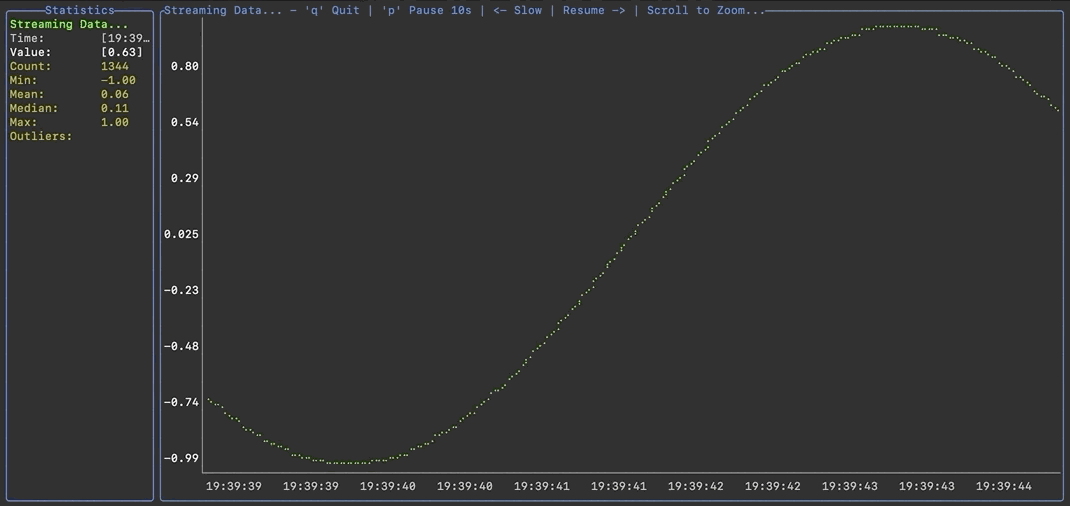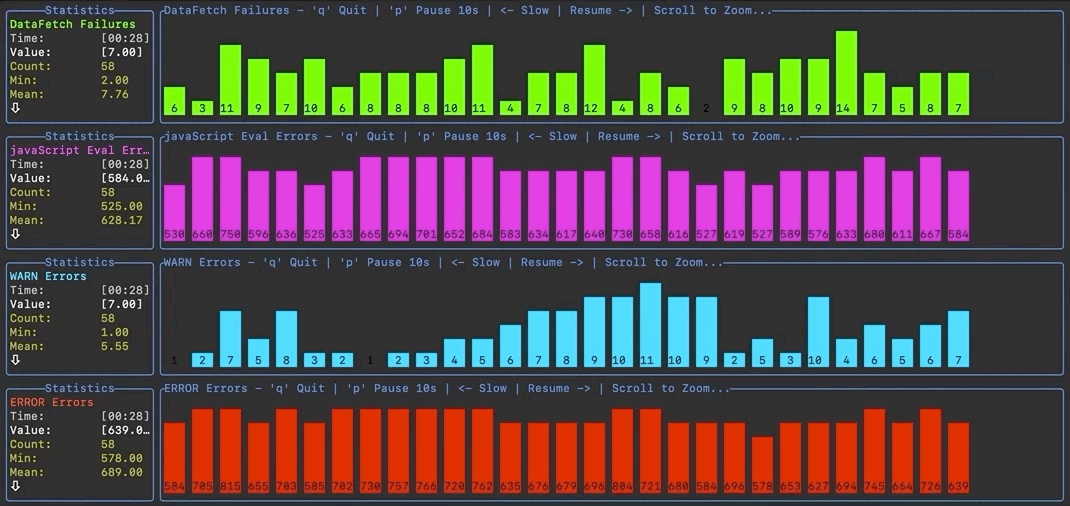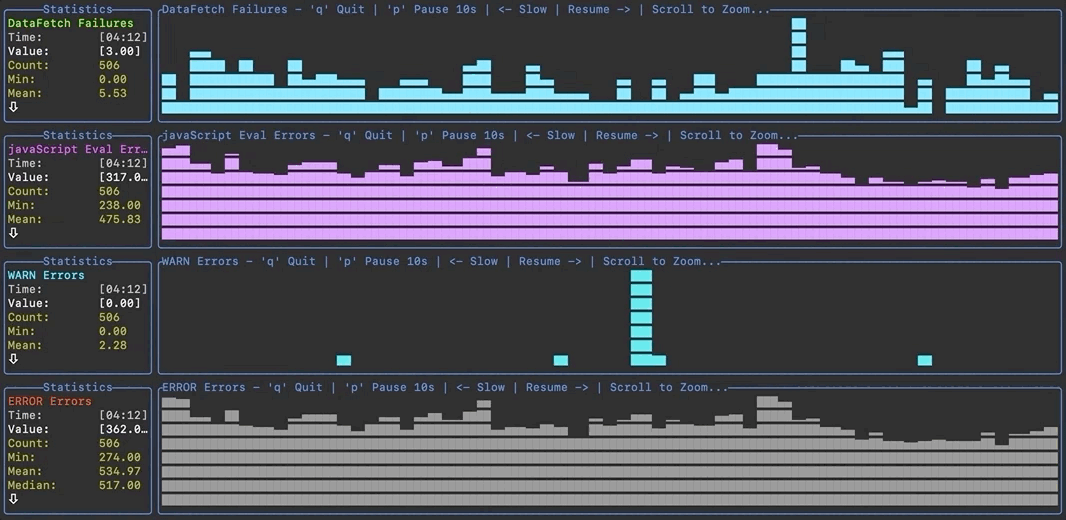https://github.com/keithknott26/datadash
Visualize and graph data in the terminal
https://github.com/keithknott26/datadash
chart charting csv go golang graph graphing graphing-application streaming-data tabular-data terminal-based terminal-ui tsv
Last synced: 8 months ago
JSON representation
Visualize and graph data in the terminal
- Host: GitHub
- URL: https://github.com/keithknott26/datadash
- Owner: keithknott26
- License: mit
- Created: 2019-02-10T08:35:15.000Z (almost 7 years ago)
- Default Branch: master
- Last Pushed: 2023-03-13T00:09:16.000Z (over 2 years ago)
- Last Synced: 2024-11-03T20:36:10.283Z (about 1 year ago)
- Topics: chart, charting, csv, go, golang, graph, graphing, graphing-application, streaming-data, tabular-data, terminal-based, terminal-ui, tsv
- Language: Go
- Homepage:
- Size: 96.8 MB
- Stars: 268
- Watchers: 8
- Forks: 14
- Open Issues: 5
-
Metadata Files:
- Readme: README.md
- License: LICENSE
Awesome Lists containing this project
- awesome-starred - keithknott26/datadash - Visualize and graph data in the terminal (golang)
- awesome-cli-apps-in-a-csv - datadash - Visualize and graph data in the terminal. (<a name="data-management"></a>Data management)
- awesome-cli-apps - datadash - Visualize and graph data in the terminal. (<a name="data-management"></a>Data management)
README
# DataDash
A data visualization tool for the terminal.
Input streaming or tabular data inside the terminal via pipe or file, and an interactive graph will be generated.
## Chart types
datadash currently supports following chart types:
* **Line**
* Plot tabular or streaming data as line graph
* Line graph supports zooming with the scroll wheel or trackpad
* Supports X-Axis Auto scaling
* Displays the average value with the -a option (customize how many values to consider using -z)
* Different color lines for each graph
* Supports scrolling for streaming data applications (disable with the --no-scroll option)
* Displays up to five graphs simultaneously
* Displays Min, Mean, Max, and Outliers
* Customize the screen redraw interval and input seek interval for high latency or low bandwidth environments
* No dependencies, only one file is required
* Sample datasets included
* **Bar**
* Support for Bar Graphs (Beta)
* **SparkLine**
* Support for SparkLine Graphs (Beta)
### Streaming Data: (Linechart)

### Streaming Data: (Barchart)

### Streaming Data: (SparkLines)

##### Demo (Streaming data):
This will continue scrolling to the right, displaying the most recent data first and removing the older data to the left.
```bash
seq 4000 | awk 'BEGIN{OFS="\t"; print "x"}{x=$1/10; print cos(x) system("sleep 0.01")}' | ./datadash --label-mode time --scroll
```
### Tabular Data:

##### Demo: (2 columns of data):
```bash
seq 4000 | awk 'BEGIN{OFS="\t"; print "x","sin(x)"}{x=$1/10; print x,sin(x); system("sleep 0.02")}' | ./datadash --label-mode time
```
##### Line graph Demo: (6 columns of data) w/ grey average line:
```bash
seq 4000 | awk 'BEGIN{OFS="\t"; print "x","sin(x)","cos(x)", "rand(x)", "rand(x)", "rand(x)"}{x=$1/10; print x,sin(x),cos(x),rand(x),rand(x),rand(x); system("sleep 0.02")}' | ./datadash -a
```
### Installation (and demo)
```bash
go get -u github.com/keithknott26/datadash
go build cmd/datadash.go
./datadash tools/sampledata/5col-errors
```
datadash can accept tabular data like CSV, TSV, or you can use a custom delimiter with the -d option. The default delimiter is tab.
### Input Methods
Input data from stdin or file.
```bash
$ cat data.txt | datadash
$ datadash data.txt
```
## Data Structure
Below are examples of the accepted data structure. More examples can be found under /tools/sampledata
##### Streaming Data (1 graph):
```bash
50
60
70
```
##### 3 Columns (2 graphs): (\t is the tab charachter)
```bash
time\tRowLabel1\tRowLabel2
00:00\t50\t100
00:01\t60\t90
00:02\t70\t80
00:08\t80\t70
23:50\t10\t10
```
## Arguments
```bash
$ usage: datadash [] []
Flags:
--help Show context-sensitive help (also try --help-long and --help-man).
--debug Enable Debug Mode
-d, --delimiter="\t" Record Delimiter:
-m, --label-mode="first" X-Axis Labels: 'first' (use the first record in the column) or 'time' (use the current time)
-s, --scroll Whether or not to scroll chart data
-a, --average-line Enables the line representing the average of values
-z, --average-seek=500 The number of values to consider when displaying the average line: (50,100,500...)
-r, --redraw-interval=10ms The interval at which objects on the screen are redrawn: (100ms,250ms,1s,5s..)
-l, --seek-interval=20ms The interval at which records (lines) are read from the datasource: (100ms,250ms,1s,5s..)
Args:
[] A file containing a label header, and data in columns separated by a delimiter 'd'. Data piped from Stdin uses the same format
```
###### A graphing application written in go using termdash, inspired by termeter.
### License
MIT